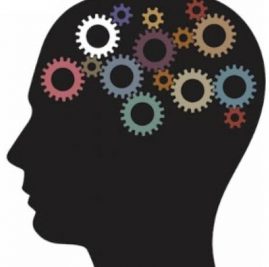Binge eating disorder is an eating disorder, like anorexia nervosa or bulimia nervosa, where individuals struggle with concerns and preoccupation around food. Often binge eating disorder and obesity are discussed together, however, only about 50-75% of those with the condition experience being overweight or obese. This condition is characterized by periods of binging, which are episodes of eating where an individual feels out of control and eats more food during a given time period (e.g., 2 hours) than another person would eat given the circumstances. For a diagnosis to be made, these binges must occur at least once a week for three months and cause significant distress in one’s life. Examples of significant distress might be having difficulty completing work because of preoccupation with food that was, or will, be eaten. Another example might be if someone no longer attends social gatherings because of difficult feelings that come up around events with food, like shame or anxiety. In other eating disorders, an individual may engage in behaviors to try to compensate for the binge, like over-exercising, self-induced vomiting, laxative use, or other behavior, but this is not the case for binge eating disorder.
It is not uncommon for individuals with one eating disorder to develop another one, or to go from one to another over time. Obese individuals with binge eating disorder more often struggle with other psychological conditions than those who are not obese. There are environmental, psychological and genetic factors that all play into the development of an eating disorder.
Here are some signs to look out for if you think you or someone you know might be struggling with binge eating disorder:
-Likely to be of a normal weight or overweight
-Shame, guilt and anxiety associated with food
-Episodes of eating that feel out of control
-Large quantities of food going missing in a short period of time or a large amount of empty food wrappers
-People with binge eating disorder tend to be “peacekeepers” in relationships
-Hiding or hoarding food
-Skipping meals or avoiding eating in front of others
-The average age of onset is 25
-Feeling numb while eating
-Embarrassment around the amount of food consumed
-Stress or tension only relieved by eating.
Fortunately, research shows promising treatments for binge eating disorder. There are psychological and medication based options for individuals to choose from, or implemented together when necessary. A study conducted by Romacciatti et al (2013) reviewed the literature on available treatment options and observed that many of the treatments proven to be effective in treating bulimia nervosa are also effective for binge eating disorder. Cognitive behavioral therapy (CBT) is the first psychological intervention to show efficacy in treating binge eating disorder. In this form of treatment, individuals learn to modify their eating and exercise habits, while finding other ways to manage uncomfortable situations or feelings that may lead to a binge. Additionally, individuals in CBT treatment are provided nutritional counseling and taught to examine beliefs that may be problematic for them, including feelings about body shape. Another form of therapy, dialectical behavior therapy (DBT), can be particularly effective for individuals struggling with comorbid mood related issues or those who have a more severe condition. In terms of medication, antidepressants are also a first line of treatment in many guidelines. The correct line of treatment can be determined with the help of a mental health profession.
To support someone struggling, keep these tips in mind:
-Be supportive
-Listen carefully
-Avoid lectures or guilt trips
-Set a positive example around food, weight, shape and exercise
-Educate yourself
-Encourage the person to seek treatment
If you or someone you know is struggling with binge eating, there are many resources available to assist in the process of support and problem-solving, including professional counseling. Call (215) 487-1330 or email us at Greenridge@intercommunityaction.org for more information about our counseling services, which include one-on-one therapy with a trained clinician.
Author: Erin Hopkins, M.A.
References
American Psychiatric Association. (2013). Diagnostic and statistical manual of mental disorders (5th ed.). Washington, DC: Author.
Ramacciotti, C. E., Coli, E., Marazziti, D., Segura-García, C., Brambilla, F., Piccinni, A., & Dell’Osso, L. (2013). Therapeutic options for binge eating disorder. Eating And Weight Disorders, 18(1), 3-9. doi:10.1007/s40519-013-0003-5

